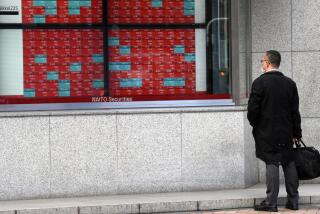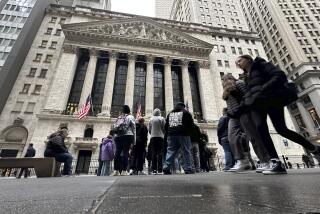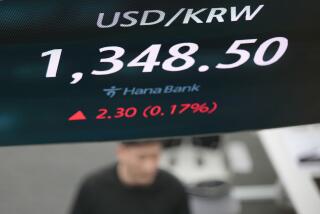64-Point Rise in Dow Is 2nd Best This Year
NEW YORK — As if expressing relief over a strengthening dollar and the receding prospects of inflation, major stocks on Wednesday posted their second-best gain of the year--a 64.16-point rise in the Dow Jones industrial average that led the New York Stock Exchange for the first time to impose a new set of restrictions on computerized trading.
The widely followed average of 30 blue-chip stocks closed at 2,061.67 points, only 26 points short of its high for the year. In point terms, the gain was the Dow’s best since it rose 76.42 points on Jan. 4, the first trading day of 1988, and its ninth-best of all time.
Trading activity finally burst loose from the lethargy of past weeks, with volume on the New York Stock Exchange reaching 189.76 million shares, contrasted with 135.29 million on Tuesday.
Automated Systems
The move was the Dow’s first of more than 50 points since early February, when the New York Stock Exchange installed an informal rule shutting its automated systems to most computer-generated buy and sell orders for the day once the Dow crosses that threshold in either direction.
The rule, which is awaiting permanent approval from federal securities regulators, is designed to avoid swamping floor traders with a rush of high-volume orders similar to those that exacerbated the tumult of the market crash last Oct. 19 and on the following day.
But many specialists in computer trading said that because trading opportunities were scarce, they largely abstained from the market Wednesday in any case.
“We were not particularly active today one way or another,” said Robert Gordon, the head of Twenty-First Securities, a leading “program trading” firm.
Instead, investors and traders appeared to be reacting more to a surge in the dollar. Indeed, the Dow average was bumping along with a scant two- or three-point gain over Tuesday’s close until after 12:30 p.m. EDT. At that point, reports attributed to the Japan Economic Journal, or Nikkei, indicated that the seven leading Western industrial countries had agreed to support the U.S. dollar at a price above 125 Japanese yen.
At the same time, reports from Tokyo indicated that Japanese traders were not dumping their holdings of dollars. This countered speculation that the Japanese would cease supporting the dollar after the end of the Japanese fiscal year on March 31; at that point, a sharp drop in the currency’s value could no longer force leading Japanese companies to take embarrassing year-end write-downs from currency speculation.
The dollar immediately surged to about 126 yen on the Nikkei report. The Dow jumped about 18 points in the next 30 minutes, investors taking heart because a stronger dollar tends to mean lower domestic interest rates. Bond prices also rose, a development that depresses interest rates and drives money into the stock market.
Report Unconfirmed
Some investors and analysts suggested that stocks reacted so strongly to the Nikkei report, which remains unconfirmed but anticipates a meeting next week of finance officials from those countries, because traders had moved stock prices excessively lower over the last few months.
Institutional investors including pension funds and mutual funds have accumulated uncharacteristically large hoards of cash to wait out an extended stock downturn.
“We hear that there’s cash burning holes in a lot of people’s pockets,” remarked Henry Greenleaf, head of H T Investors, a Providence, R.I., money-management firm.
“The market’s really been scouring for any kind of stimulative move,” added Eugene Peroni, technical market strategist for Janney Montgomery Scott, a Philadelphia investment firm.
Wednesday’s rally encompassed all but one of the Dow industrial average’s 30 stocks. The lone holdout was F. W. Woolworth Co., a takeover target that dropped $1.875 a share to $54.875; analysts considered that a predictable breather after the five-and-dime chain’s immense $11.50-a-share run-up over the previous two days.
Major Indexes Gained
Beyond the Dow, all major stock indexes posted strong gains. The Standard & Poor’s index of 500 institutional stocks closed at 265.49, up 6.98; the NYSE composite average closed at 149.76, up 3.47; the American Stock Exchange composite gained 2.51 to close at 297.58, and the over-the-counter composite gained 4.33 to close at 377.74.
For many stock investors and analysts, the most interesting point of Wednesday’s trading came at 3:24 p.m. EDT, when the Dow’s move exceeded 50 points for the first time since the Big Board’s self-imposed trading restrictions were established. The average almost immediately dropped back to the equivalent of a 49-point gain but then resumed its march for the final half-hour of trading.
The trading restriction is aimed at so-called index arbitragers. These are professional traders who simultaneously play the stock and stock-index futures markets. Index futures are contracts traded in Chicago that are designed to represent bets on the general direction of stock prices in the future, using as a proxy such leading indexes as the Standard & Poor’s 500.
When the index future moves significantly higher than the index itself, an arbitrager sells the index and buys a representative volume of the index’s component stocks, guaranteeing himself a profit equivalent to the price discrepancy. The trade works in reverse when the index future is lower than the index.
Split-Second Timing
Because these tandem trades must generally be executed with split-second timing, in large volume and at a precise price, “arbs” rely on the NYSE’s automated order placement system known as DOT (for “direct order turnaround”), which allows huge orders to be transmitted instantaneously to floor traders. On Oct. 19 and 20, DOT became jammed with sell orders for millions of stocks, creating an electronic traffic jam that contributed to the market’s fearsome chaos.
The exchange hopes its restrictions will cut off any such surge in big orders by forcing these traders to submit their orders to human floor brokers on the trading floor, who move at much less than the speed of light.
Yet index arbitragers said the discrepancy between stock and futures prices was too small all day Wednesday to invite any significant computer trading, whether before the 50-point threshold was breached or after.
“There were no opportunities for us,” said Eric Seff, chief trader for Chase Investors Management Corp., a leading arbitrage firm. “We just sat back and enjoyed a nice orderly market.”
The discrepancy, or “spread,” between the S&P; 500 index and its futures contract expiring in June barely exceeded 2 points (out of the index close of 265.49) at any point in the day, noted Gordon of Twenty-First Securities. Because brokerage fees, interest costs and other expenses cut into trading profits, he said, the spread would have to come close to three points for any significant profit opportunity to appear.
“For us, Wednesday was pretty much a non-event,” he said. “Nothing was really learned from the experience.”
More to Read
Inside the business of entertainment
The Wide Shot brings you news, analysis and insights on everything from streaming wars to production — and what it all means for the future.
You may occasionally receive promotional content from the Los Angeles Times.










